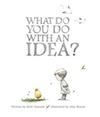
What Do You Do with an Idea?
Written by Kobi Yamada
Illustrated by Mae Benson
Compendium Inc., 2014, 36 pp.
ISBN: 9781938298073
I liked being with my idea. It made me feel more alive, like I could do anything. It encouraged me to think big…and then, to think bigger. (p. 23)
This must-read book is a story that will stay with you forever, impacting young and old alike. Kobi Yamada carefully and thoughtfully tells the story of a little boy who has an idea. He is not sure what to do with his idea and ponders a plan. Should he abandon it, nurture it, believe in it? While trying each path, he realizes he is happier and more content with his idea by his side. He comes to understand that his idea does as much for him as he can do for his idea. While there is only one character in the text, he is a neutral character and anyone could likely identify with him. The focus is on the idea that is growing and becoming ever-present. In the end, Yamada sends a deep yet direct message suggesting the importance of our ideas, no matter how big or how small.
Mae Besom’s illustrations could not be more complimentary in bringing the text to life and adding to the story. Besom illustrates the idea as an egg waiting to hatch. This allows the reader to engage with the story and think deeply about what it is like to carry around an idea. The illustrations become more colorful as the idea develops and is more alive and powerful in the little boy’s life. The whimsical appearance of the illustrations opens the door imagination and creativity. The illustrations become more colorful as the text develops, demonstrating that the idea becomes more alive and powerful in the boy’s life. Their whimsical appearance opens the door to imagination and creativity.
What Do You Do With an Idea? is an exemplar text, mentoring students in the pairing of text and illustrations, creativity, perseverance, and staying true to yourself. Students of all ages will appreciate this text because of its applicability to a variety of contexts and its invitation to thoughtful response. Other texts may pair well with What Do You Do With an Idea? to deepen students’ thinking and creativity. For example, The Most Magnificent Thing by Ashley Spires (2014) is a fun story of a little girl, her dog, and her uncultivated creativity to make the most magnificent thing. Her ability to stay true to herself is a life lesson and a parallel to the young boy and his egg. Going Places by Peter Reynolds (2014) is about a young boy and young girl who use creativity to tackle a school project as a team instead of working by themselves. While they are faced with their own skepticism and self-doubt along the way, they overcome the obstacles to find success and feel good about themselves. In July of 2016, Yamada will release a new text titled What Do You Do With a Problem? This would make an interesting pairing.
Yamada is the CEO and president of Compendium Inc., a company that is a successful business, but also cares about people and contributing to people’s lives. Mae Besom began her art career in China and in 2007 decided to become a full-time children’s book illustrator. This was Yamada’s first children’s book. Besom will illustrate Yamada’s next book as well. More about Yamada can be found at his website: More about Besom can be found at this web address.
Rebecca Gasiewicz, University of Cincinnati, Cincinnati, OH
WOW Review, Volume VIII, Issue 4 by Worlds of Words is licensed under a Creative Commons Attribution-NonCommercial-ShareAlike 4.0 International License. Based on work at https://wowlit.org/on-line-publications/review/viii-4/
